中考英语复习语法突破第八节谓语动词的时态课件(共45张PPT)
文档属性
| 名称 | 中考英语复习语法突破第八节谓语动词的时态课件(共45张PPT) |  | |
| 格式 | ppt | ||
| 文件大小 | 762.0KB | ||
| 资源类型 | 教案 | ||
| 版本资源 | 通用版 | ||
| 科目 | 英语 | ||
| 更新时间 | 2024-03-01 16:56:13 | ||
图片预览

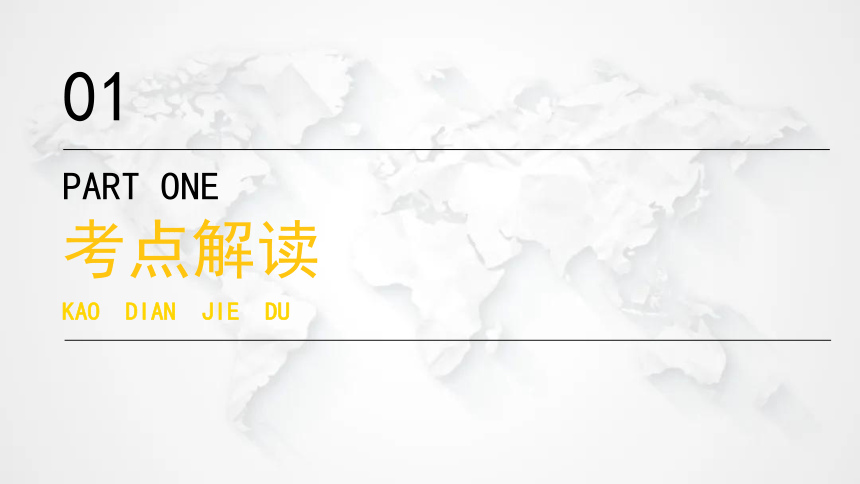
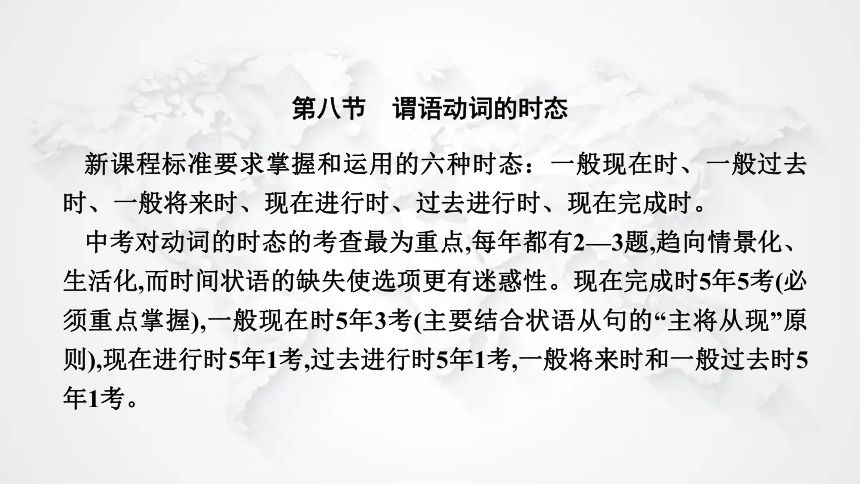

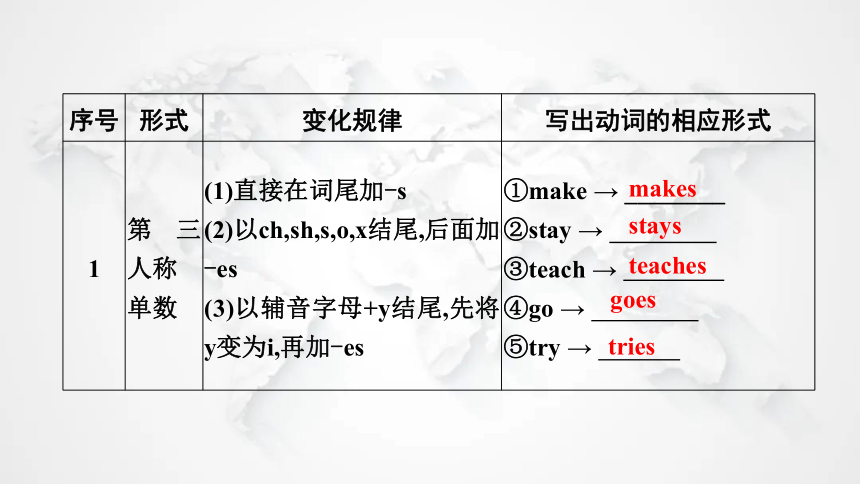

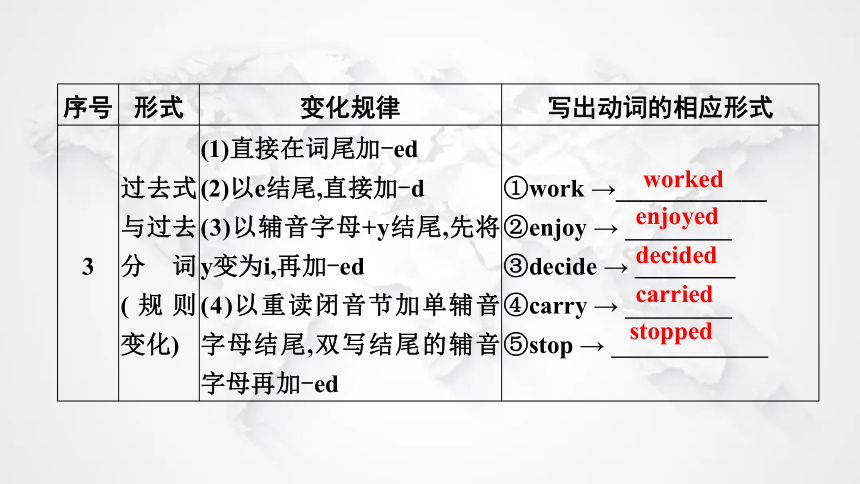

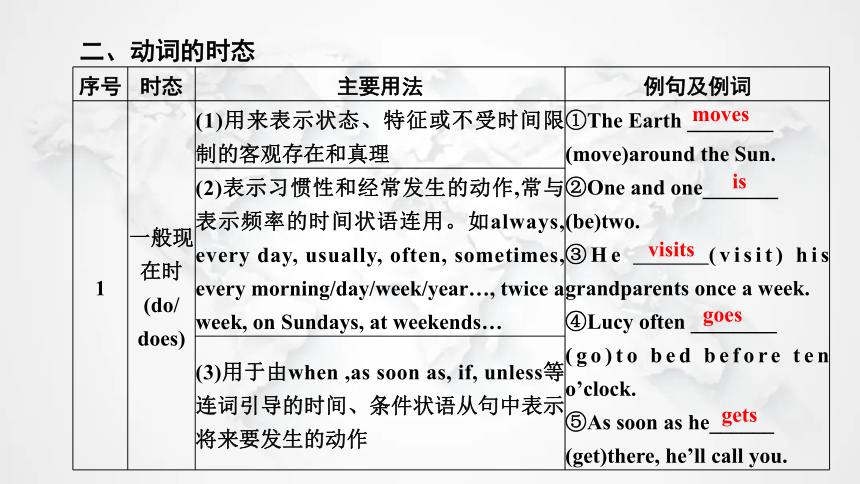
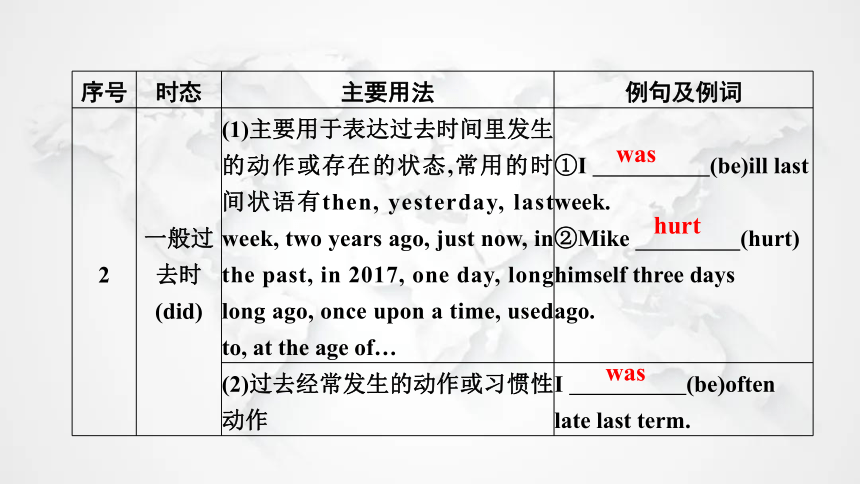
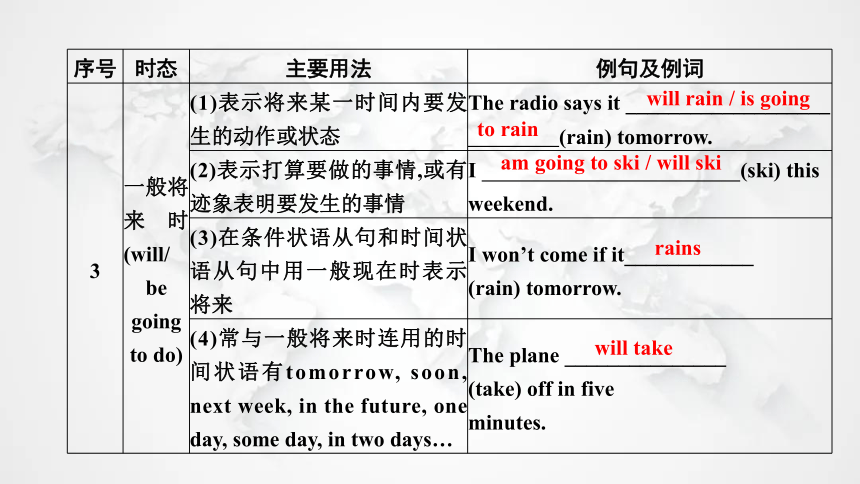

文档简介
(共45张PPT)
考点解读
01
KAO DIAN JIE DU
满分突破
02
MAN FEN TU PO
真题链接
03
ZHEN TI LIAN JIE
CONTENTS
目录
模拟突破
04
MO NI TU PO
考点解读
KAO DIAN JIE DU
PART ONE
01
第八节 谓语动词的时态
新课程标准要求掌握和运用的六种时态:一般现在时、一般过去时、一般将来时、现在进行时、过去进行时、现在完成时。
中考对动词的时态的考查最为重点,每年都有2—3题,趋向情景化、生活化,而时间状语的缺失使选项更有迷惑性。现在完成时5年5考(必须重点掌握),一般现在时5年3考(主要结合状语从句的“主将从现”原则),现在进行时5年1考,过去进行时5年1考,一般将来时和一般过去时5年1考。
一、动词的形式
绝大多数动词有五种基本形式,即动词原形、过去式、过去分词、现在分词和第三人称单数。如:go — went — gone — going — goes。它们的形式及构成详见下表。
序号 形式 变化规律 写出动词的相应形式
1 第三人称
单数 (1)直接在词尾加-s
(2)以ch,sh,s,o,x结尾,后面加-es
(3)以辅音字母+y结尾,先将y变为i,再加-es ①make → ________
②stay →
③teach →
④go →
⑤try →
makes
stays
teaches
goes
tries
序号 形式 变化规律 写出动词的相应形式
2 现在分词 (1)直接在词尾加-ing
(2)以不发音的e结尾,去掉e再加-ing
(3)以重读闭音节加单辅音字母结尾,双写结尾的辅音字母再加-ing
(4)以ie结尾,先将ie变为y,再加-ing ①eat →_____________
②play →
③write →
④swim →
⑤die →
⑥lie →
eating
playing
writing
swimming
dying
lying
序号 形式 变化规律 写出动词的相应形式
3 过去式与过去分词(规则变化) (1)直接在词尾加-ed
(2)以e结尾,直接加-d
(3)以辅音字母+y结尾,先将y变为i,再加-ed
(4)以重读闭音节加单辅音字母结尾,双写结尾的辅音字母再加-ed ①work →____________
②enjoy →
③decide →
④carry →
⑤stop →
worked
enjoyed
decided
carried
stopped
说明:不规则动词的过去式与过去分词要根据不规则动词表逐个记忆(见中考英语短语与句型复习手册——易错词、不规则变化的词)。
二、动词的时态
序号 时态 主要用法 例句及例词
1 一般现在时
(do/
does) (1)用来表示状态、特征或不受时间限制的客观存在和真理 ①The Earth ________
(move)around the Sun.
②One and one_______
(be)two.
③He (visit) his grandparents once a week.
④Lucy often ________
(go)to bed before ten o’clock.
⑤As soon as he______
(get)there, he’ll call you.
(2)表示习惯性和经常发生的动作,常与表示频率的时间状语连用。如always, every day, usually, often, sometimes, every morning/day/week/year…, twice a week, on Sundays, at weekends…
(3)用于由when ,as soon as, if, unless等连词引导的时间、条件状语从句中表示将来要发生的动作
moves
is
visits
goes
gets
序号 时态 主要用法 例句及例词
2 一般过去时
(did) (1)主要用于表达过去时间里发生的动作或存在的状态,常用的时间状语有then, yesterday, last week, two years ago, just now, in the past, in 2017, one day, long long ago, once upon a time, used to, at the age of… ①I (be)ill last
week.
②Mike (hurt)
himself three days
ago.
(2)过去经常发生的动作或习惯性动作 I (be)often
late last term.
was
hurt
was
序号 时态 主要用法 例句及例词
3 一般将来时(will/
be going to do) (1)表示将来某一时间内要发生的动作或状态 The radio says it ___________________
(rain) tomorrow.
(2)表示打算要做的事情,或有迹象表明要发生的事情 I (ski) this
weekend.
(3)在条件状语从句和时间状语从句中用一般现在时表示将来 I won’t come if it____________
(rain) tomorrow.
(4)常与一般将来时连用的时间状语有tomorrow, soon, next week, in the future, one day, some day, in two days… The plane _______________
(take) off in five
minutes.
will rain / is going
to rain
am going to ski / will ski
rains
will take
序号 时态 主要用法 例句及例词
4
现在进行时(am/is/are doing)
(1)用于表示现在正在进行的动作,也可以表示在最近一段时间内一直或反复进行的动作。注意:表状态、情感的动词没有现在进行时,这些动词有like, have(有), love, know, see, hear, smell,
taste, wish, hope, forget, understand, remember等
时间标志:look, listen, now, right now, at present, at this time, at the/this moment, these days, when, while… ①I ________________
(watch)
TV at the moment.
②The workers _____
____________________(build) a school these days.
(2)go,come,leave,start,move,sail,arrive,reach,get to等表示位置移动的动词的现在进行时可表示将来 I’m coming.
He _______________
(leave)tomorrow.
am watching
are building
is leaving
序号 时态 主要用法 例句及例词
5 过去进行时
(was/
were doing) (1)表示过去某一时刻、某一阶段正在进行的动作。常用时间状语有then, at that time, at ten yesterday, at this time yesterday, at that moment等 In 1980 he was studying in a university.
I (wash)
clothes at that time.
(2)用于由when, while引导的时间状语从句中 He fell asleep when/
while he_____________
(read)his newspaper.
was washing
was reading
序号 时态 主要用法 例句及例词
6 现在完成时
(have/has done) (1)用来表达从过去开始的动作持续到现在。常与for和since表示一段时间的状语(for+时间段,since+时间点)或so far, up to now, in the past/last three years, recently, lately等包括现在时间在内的时间状语连用 ①I (study)
English for two years.
②We __________________
(learn)3,000 English words so far.
(2)用来表示过去发生的动作对现在造成的影响或结果。常与already, ever, never, just, yet, before等副词连用 I (not have)my breakfast yet, so I’m hungry now.
have studied
have learned / learnt
haven’t had
序号 时态 主要用法 例句及例词
7 现在完成时
(have/has done) (3)注意:瞬间动词不能和表示一段时间的for短语和since短语连用,也不能用于how long引导的疑问句中。如果要用,应先把瞬间动词改为相应的持续性动词。如:
become—be borrow—keep
buy—have open—be open
die—be dead leave—be away
close—be closed finish—be over
begin(start)—be on/last
join—be in How long have you kept this book?
这本书你借了多久?
Mike has been away for ten days.
迈克离开已有十天了。
三、易错点突破
1. 一般过去时与过去进行时的用法比较
一般过去时表示的动作或状态已结束;而过去进行时表示的动作在过去某个时间正在进行,可能完成了,也可能未完成。
如:Mary wrote a letter to her friend last night. 玛丽昨晚给她的朋友写了封信。(信已写完)
Mary was writing a letter to her friend last night.
昨晚玛丽在给她的朋友写信。(信不一定写完)
(1)He always (go) to work by bus last year.
(2)When we arrived, she (make) some fresh coffee.
went
was making
2. 现在完成时与一般过去时的区别
现在完成时表示过去发生的动作对现在造成的影响或结果,强调的是现在。与现在完成时连用的时间状语有 already, yet, still, just, so far, in the last (past) few years, before, ever, never, since+时间点,for+时间段等。现在完成时不与具体的过去时间连用,如yesterday, last week, two days ago等。
一般过去时只表明过去的动作或状态,与现在无关,常与具体的过去时间连用,如ago, yesterday, last year, in 2002, just now等。
如:He has lived in New York for eight years. 他在纽约已经住了八年了。(他现在仍在纽约)
He lived in New York for eight years. 他在纽约住了八年。(他现在可能不在纽约了)
(1)They (live) here since 1983.
(2)I (see) this film yesterday.
(3)I already (see) this film.
(4)Ann (visit) her uncle last weekend.
have lived
saw
have
seen
visited
3. have/has been to, have/has gone to, have/has been in的区别
have/has gone to意为“到某地去”,说话时该人不在现场;have/has been to意为“曾经去过某地”,现在已经回来了,后面可接次数,如once, twice, three times等,表示“去过某地几次”,也可和 just, never, ever等连用;have/has been in表示“在某地待了多长时间”,常与表一段时间的状语连用。如:
(1)Mr. Wang isn’t here. He Qingdao.
(2)He London for half a month.
(3)My father Beijing twice.
(4)I never the Great Wall.
(5)I Shanghai for three years.
has gone to
has been in
has been to
have
been to
have been in
满分突破
MAN FEN TU PO
PART TWO
02
在语法选择和短文填空中,动词的时态主要通过上下文确定,因为语法选择和短文填空多为哲理性小故事,所以一般过去时考查得比较多,时态需根据全文确定,或者找到该句的时间状语,将符合意思的动词进行变形。
一、动词的时态在语法选择中的考查
1. (2021·广东中考·37题)Now the city is hoping that the bridge_______
lots of tourists to the area.
A. brought B. will bring C. is bringing D. was bringing
B
2. (2021·广州中考· 5题)He works so hard in the field, but now it_____ up.
A. dry B. is drying C. dried D. was drying
3. (2022·广东中考· 39题)She herself that she still had a long way to go and that she should keep practicing …
A. tell B. tells C. told
B
C
4. (2022·广州中考· 13题)“ Running water from the tap can be harmful to fish,” Dad explained. “That we can’t put Bob into fresh water right away. ”
A. mean B. means C. meant D. is meaning
5. (2023·广东中考·15题)These experiences have influenced his life. Now David space science.
A. study B. is studying C. was studying
B
B
6. (2023·广州中考· 12题)Mama Bird brought them together and____ them to fly.
A. teach B. teaches C. taught D. will teach
7. (2023·汕头市潮阳区一模)Xuemo, the pen name of Chen Kaihong,
many good works since 1988.
A. created B. has created C. is creating
C
B
8. (2023·阳江市二模)I about this thing often over the past years.
A. thought B. have thought C. will think
B
二、动词的时态在短文填空中的考查
1. (2022· 广东中考·72题)And now it has popular in Europe and America.
become / been
2.
(2023· 广东中考·43题)According to some research, before
toothbrushes appeared, the ancient Chinese people their teeth with some small tree branches (树枝).
it either be because what else by invent clean popular habit hundred
cleaned
真题链接
ZHEN TI LIAN JIE
PART THREE
03
( )1. I ice skating this Sunday. Do you want to come? (2023·河北省)
A. go B. went C. was going D. will go
D
( )2. International search and rescue (救援) teams have rushed to Turkey to help for the huge earthquakes. China an 82-member China Search and Rescue Team.
(2023·黄石市)
A. sends B. was sent
C. has sent D. has been sent
C
( )3. — Peter, what were you doing at this time last night?
— I chess with my grandfather. (2023·镇江市)
A. play B. was playing
C. am playing D. played
B
( )4. — Su Hai, what will you do for the coming Father’s Day?
— I a beautiful card for my father. (2023·淮安市)
A. design B. designed C. will design D. was designing
C
( )5. Jessica every night before her Chinese test and got good results.
(2023·武汉市)
A. studies B. studied C. has studied D. will study
B
( )6. If you heat ice, it into water. (2023·天水市)
A. turns B. turned C. was turning D. has turned
( )7. The book must be great. My sister it five times. (2023·河北省)
A. reads B. has read C. is reading D. was reading
A
B
( )8. — Lucy, what are you doing?
— I a model ship. (2023·北京市)
A. make B. made C. am making D. was making
C
( )9. If you go to the concert with us tomorrow, you a great time here.
(2023·北京市)
A. have B. had C. will have D. have had
C
( )10. Could you please turn down the TV Your father_______ on his article.
(2023·长春市)
A. was working B. worked
C. is working D. works
C
模拟突破
MO NI TU PO
PART FOUR
04
语法选择(主要考查时态)(2023·惠州二模)
Katy is an actress and a player as well. She is a person who refuses 1 the words “no” or “I can’t”.
She was born without the lower half of her legs. She 2 prosthetic (假肢的) legs all her life since she was four. She had an active childhood. She kept up with her sisters and brothers at the gym and in the swimming pool. She feels 3 . Her family has treated her in the same way as 4 members.
When a person is born without legs,there are lots of things that are difficult to do. 5 Katy believes she can do anything. She chose to do two things that are difficult even with both legs.
6 a teenager, she saw a movie that was very meaningful to her. Before it was over, Katy had made her mind up to be an actress.
She got a degree in theater and then she played roles in theater, television and movies. She thinks that if you believe you can do something, you should go for it. So when Katy’s friend asked her whether 7 to try running, she said “yes”. She 8 a pair of running legs and started running.
Katy was 9 first person in the world with two prosthetic legs to take up running as a competitive sport.
Katy has a 10 will than many other people. Her family, friends and fans look up to her as an example of someone who has got over difficulties and achieved her dreams.
( )1. A. use B. using C. to use
( )2. A. has worn B. wore C. wears
( )3. A. luck B. lucky C. luckily
( )4. A. the other B. another C. others
( )5. A. Or B. And C. But
( )6. A. Of B. As C. From
( )7. A. did she want B. she wants C. she wanted
( )8. A. gave B. will be given C. was given
( )9. A. the B. a C. an
( )10. A. strong B. stronger C. strongest
C
A
B
A
C
B
C
C
A
B
考点解读
01
KAO DIAN JIE DU
满分突破
02
MAN FEN TU PO
真题链接
03
ZHEN TI LIAN JIE
CONTENTS
目录
模拟突破
04
MO NI TU PO
考点解读
KAO DIAN JIE DU
PART ONE
01
第八节 谓语动词的时态
新课程标准要求掌握和运用的六种时态:一般现在时、一般过去时、一般将来时、现在进行时、过去进行时、现在完成时。
中考对动词的时态的考查最为重点,每年都有2—3题,趋向情景化、生活化,而时间状语的缺失使选项更有迷惑性。现在完成时5年5考(必须重点掌握),一般现在时5年3考(主要结合状语从句的“主将从现”原则),现在进行时5年1考,过去进行时5年1考,一般将来时和一般过去时5年1考。
一、动词的形式
绝大多数动词有五种基本形式,即动词原形、过去式、过去分词、现在分词和第三人称单数。如:go — went — gone — going — goes。它们的形式及构成详见下表。
序号 形式 变化规律 写出动词的相应形式
1 第三人称
单数 (1)直接在词尾加-s
(2)以ch,sh,s,o,x结尾,后面加-es
(3)以辅音字母+y结尾,先将y变为i,再加-es ①make → ________
②stay →
③teach →
④go →
⑤try →
makes
stays
teaches
goes
tries
序号 形式 变化规律 写出动词的相应形式
2 现在分词 (1)直接在词尾加-ing
(2)以不发音的e结尾,去掉e再加-ing
(3)以重读闭音节加单辅音字母结尾,双写结尾的辅音字母再加-ing
(4)以ie结尾,先将ie变为y,再加-ing ①eat →_____________
②play →
③write →
④swim →
⑤die →
⑥lie →
eating
playing
writing
swimming
dying
lying
序号 形式 变化规律 写出动词的相应形式
3 过去式与过去分词(规则变化) (1)直接在词尾加-ed
(2)以e结尾,直接加-d
(3)以辅音字母+y结尾,先将y变为i,再加-ed
(4)以重读闭音节加单辅音字母结尾,双写结尾的辅音字母再加-ed ①work →____________
②enjoy →
③decide →
④carry →
⑤stop →
worked
enjoyed
decided
carried
stopped
说明:不规则动词的过去式与过去分词要根据不规则动词表逐个记忆(见中考英语短语与句型复习手册——易错词、不规则变化的词)。
二、动词的时态
序号 时态 主要用法 例句及例词
1 一般现在时
(do/
does) (1)用来表示状态、特征或不受时间限制的客观存在和真理 ①The Earth ________
(move)around the Sun.
②One and one_______
(be)two.
③He (visit) his grandparents once a week.
④Lucy often ________
(go)to bed before ten o’clock.
⑤As soon as he______
(get)there, he’ll call you.
(2)表示习惯性和经常发生的动作,常与表示频率的时间状语连用。如always, every day, usually, often, sometimes, every morning/day/week/year…, twice a week, on Sundays, at weekends…
(3)用于由when ,as soon as, if, unless等连词引导的时间、条件状语从句中表示将来要发生的动作
moves
is
visits
goes
gets
序号 时态 主要用法 例句及例词
2 一般过去时
(did) (1)主要用于表达过去时间里发生的动作或存在的状态,常用的时间状语有then, yesterday, last week, two years ago, just now, in the past, in 2017, one day, long long ago, once upon a time, used to, at the age of… ①I (be)ill last
week.
②Mike (hurt)
himself three days
ago.
(2)过去经常发生的动作或习惯性动作 I (be)often
late last term.
was
hurt
was
序号 时态 主要用法 例句及例词
3 一般将来时(will/
be going to do) (1)表示将来某一时间内要发生的动作或状态 The radio says it ___________________
(rain) tomorrow.
(2)表示打算要做的事情,或有迹象表明要发生的事情 I (ski) this
weekend.
(3)在条件状语从句和时间状语从句中用一般现在时表示将来 I won’t come if it____________
(rain) tomorrow.
(4)常与一般将来时连用的时间状语有tomorrow, soon, next week, in the future, one day, some day, in two days… The plane _______________
(take) off in five
minutes.
will rain / is going
to rain
am going to ski / will ski
rains
will take
序号 时态 主要用法 例句及例词
4
现在进行时(am/is/are doing)
(1)用于表示现在正在进行的动作,也可以表示在最近一段时间内一直或反复进行的动作。注意:表状态、情感的动词没有现在进行时,这些动词有like, have(有), love, know, see, hear, smell,
taste, wish, hope, forget, understand, remember等
时间标志:look, listen, now, right now, at present, at this time, at the/this moment, these days, when, while… ①I ________________
(watch)
TV at the moment.
②The workers _____
____________________(build) a school these days.
(2)go,come,leave,start,move,sail,arrive,reach,get to等表示位置移动的动词的现在进行时可表示将来 I’m coming.
He _______________
(leave)tomorrow.
am watching
are building
is leaving
序号 时态 主要用法 例句及例词
5 过去进行时
(was/
were doing) (1)表示过去某一时刻、某一阶段正在进行的动作。常用时间状语有then, at that time, at ten yesterday, at this time yesterday, at that moment等 In 1980 he was studying in a university.
I (wash)
clothes at that time.
(2)用于由when, while引导的时间状语从句中 He fell asleep when/
while he_____________
(read)his newspaper.
was washing
was reading
序号 时态 主要用法 例句及例词
6 现在完成时
(have/has done) (1)用来表达从过去开始的动作持续到现在。常与for和since表示一段时间的状语(for+时间段,since+时间点)或so far, up to now, in the past/last three years, recently, lately等包括现在时间在内的时间状语连用 ①I (study)
English for two years.
②We __________________
(learn)3,000 English words so far.
(2)用来表示过去发生的动作对现在造成的影响或结果。常与already, ever, never, just, yet, before等副词连用 I (not have)my breakfast yet, so I’m hungry now.
have studied
have learned / learnt
haven’t had
序号 时态 主要用法 例句及例词
7 现在完成时
(have/has done) (3)注意:瞬间动词不能和表示一段时间的for短语和since短语连用,也不能用于how long引导的疑问句中。如果要用,应先把瞬间动词改为相应的持续性动词。如:
become—be borrow—keep
buy—have open—be open
die—be dead leave—be away
close—be closed finish—be over
begin(start)—be on/last
join—be in How long have you kept this book?
这本书你借了多久?
Mike has been away for ten days.
迈克离开已有十天了。
三、易错点突破
1. 一般过去时与过去进行时的用法比较
一般过去时表示的动作或状态已结束;而过去进行时表示的动作在过去某个时间正在进行,可能完成了,也可能未完成。
如:Mary wrote a letter to her friend last night. 玛丽昨晚给她的朋友写了封信。(信已写完)
Mary was writing a letter to her friend last night.
昨晚玛丽在给她的朋友写信。(信不一定写完)
(1)He always (go) to work by bus last year.
(2)When we arrived, she (make) some fresh coffee.
went
was making
2. 现在完成时与一般过去时的区别
现在完成时表示过去发生的动作对现在造成的影响或结果,强调的是现在。与现在完成时连用的时间状语有 already, yet, still, just, so far, in the last (past) few years, before, ever, never, since+时间点,for+时间段等。现在完成时不与具体的过去时间连用,如yesterday, last week, two days ago等。
一般过去时只表明过去的动作或状态,与现在无关,常与具体的过去时间连用,如ago, yesterday, last year, in 2002, just now等。
如:He has lived in New York for eight years. 他在纽约已经住了八年了。(他现在仍在纽约)
He lived in New York for eight years. 他在纽约住了八年。(他现在可能不在纽约了)
(1)They (live) here since 1983.
(2)I (see) this film yesterday.
(3)I already (see) this film.
(4)Ann (visit) her uncle last weekend.
have lived
saw
have
seen
visited
3. have/has been to, have/has gone to, have/has been in的区别
have/has gone to意为“到某地去”,说话时该人不在现场;have/has been to意为“曾经去过某地”,现在已经回来了,后面可接次数,如once, twice, three times等,表示“去过某地几次”,也可和 just, never, ever等连用;have/has been in表示“在某地待了多长时间”,常与表一段时间的状语连用。如:
(1)Mr. Wang isn’t here. He Qingdao.
(2)He London for half a month.
(3)My father Beijing twice.
(4)I never the Great Wall.
(5)I Shanghai for three years.
has gone to
has been in
has been to
have
been to
have been in
满分突破
MAN FEN TU PO
PART TWO
02
在语法选择和短文填空中,动词的时态主要通过上下文确定,因为语法选择和短文填空多为哲理性小故事,所以一般过去时考查得比较多,时态需根据全文确定,或者找到该句的时间状语,将符合意思的动词进行变形。
一、动词的时态在语法选择中的考查
1. (2021·广东中考·37题)Now the city is hoping that the bridge_______
lots of tourists to the area.
A. brought B. will bring C. is bringing D. was bringing
B
2. (2021·广州中考· 5题)He works so hard in the field, but now it_____ up.
A. dry B. is drying C. dried D. was drying
3. (2022·广东中考· 39题)She herself that she still had a long way to go and that she should keep practicing …
A. tell B. tells C. told
B
C
4. (2022·广州中考· 13题)“ Running water from the tap can be harmful to fish,” Dad explained. “That we can’t put Bob into fresh water right away. ”
A. mean B. means C. meant D. is meaning
5. (2023·广东中考·15题)These experiences have influenced his life. Now David space science.
A. study B. is studying C. was studying
B
B
6. (2023·广州中考· 12题)Mama Bird brought them together and____ them to fly.
A. teach B. teaches C. taught D. will teach
7. (2023·汕头市潮阳区一模)Xuemo, the pen name of Chen Kaihong,
many good works since 1988.
A. created B. has created C. is creating
C
B
8. (2023·阳江市二模)I about this thing often over the past years.
A. thought B. have thought C. will think
B
二、动词的时态在短文填空中的考查
1. (2022· 广东中考·72题)And now it has popular in Europe and America.
become / been
2.
(2023· 广东中考·43题)According to some research, before
toothbrushes appeared, the ancient Chinese people their teeth with some small tree branches (树枝).
it either be because what else by invent clean popular habit hundred
cleaned
真题链接
ZHEN TI LIAN JIE
PART THREE
03
( )1. I ice skating this Sunday. Do you want to come? (2023·河北省)
A. go B. went C. was going D. will go
D
( )2. International search and rescue (救援) teams have rushed to Turkey to help for the huge earthquakes. China an 82-member China Search and Rescue Team.
(2023·黄石市)
A. sends B. was sent
C. has sent D. has been sent
C
( )3. — Peter, what were you doing at this time last night?
— I chess with my grandfather. (2023·镇江市)
A. play B. was playing
C. am playing D. played
B
( )4. — Su Hai, what will you do for the coming Father’s Day?
— I a beautiful card for my father. (2023·淮安市)
A. design B. designed C. will design D. was designing
C
( )5. Jessica every night before her Chinese test and got good results.
(2023·武汉市)
A. studies B. studied C. has studied D. will study
B
( )6. If you heat ice, it into water. (2023·天水市)
A. turns B. turned C. was turning D. has turned
( )7. The book must be great. My sister it five times. (2023·河北省)
A. reads B. has read C. is reading D. was reading
A
B
( )8. — Lucy, what are you doing?
— I a model ship. (2023·北京市)
A. make B. made C. am making D. was making
C
( )9. If you go to the concert with us tomorrow, you a great time here.
(2023·北京市)
A. have B. had C. will have D. have had
C
( )10. Could you please turn down the TV Your father_______ on his article.
(2023·长春市)
A. was working B. worked
C. is working D. works
C
模拟突破
MO NI TU PO
PART FOUR
04
语法选择(主要考查时态)(2023·惠州二模)
Katy is an actress and a player as well. She is a person who refuses 1 the words “no” or “I can’t”.
She was born without the lower half of her legs. She 2 prosthetic (假肢的) legs all her life since she was four. She had an active childhood. She kept up with her sisters and brothers at the gym and in the swimming pool. She feels 3 . Her family has treated her in the same way as 4 members.
When a person is born without legs,there are lots of things that are difficult to do. 5 Katy believes she can do anything. She chose to do two things that are difficult even with both legs.
6 a teenager, she saw a movie that was very meaningful to her. Before it was over, Katy had made her mind up to be an actress.
She got a degree in theater and then she played roles in theater, television and movies. She thinks that if you believe you can do something, you should go for it. So when Katy’s friend asked her whether 7 to try running, she said “yes”. She 8 a pair of running legs and started running.
Katy was 9 first person in the world with two prosthetic legs to take up running as a competitive sport.
Katy has a 10 will than many other people. Her family, friends and fans look up to her as an example of someone who has got over difficulties and achieved her dreams.
( )1. A. use B. using C. to use
( )2. A. has worn B. wore C. wears
( )3. A. luck B. lucky C. luckily
( )4. A. the other B. another C. others
( )5. A. Or B. And C. But
( )6. A. Of B. As C. From
( )7. A. did she want B. she wants C. she wanted
( )8. A. gave B. will be given C. was given
( )9. A. the B. a C. an
( )10. A. strong B. stronger C. strongest
C
A
B
A
C
B
C
C
A
B
同课章节目录
- 词法
- 名词
- 动词和动词短语
- 动词语态
- 动词时态
- 助动词和情态动词
- 非谓语动词
- 冠词
- 代词
- 数词和量词
- 形容词副词及其比较等级
- 介词和介词短语
- 连词和感叹词
- 构词法
- 相似、相近词比较
- 句法
- 陈述句
- 一般疑问句和否定疑问句
- 特殊疑问句及选择疑问句
- 反意疑问句
- 存在句(There be句型)
- 宾语从句
- 定语从句
- 状语从句
- 主谓一致问题
- 简单句
- 并列句
- 复合句
- 主谓一致
- 主、表语从句
- 名词性从句
- 直接引语和间接引语
- 虚拟语气
- 感叹句
- 强调句
- 倒装句
- 祈使句
- 句子的成分
- 句子的分类
- 题型专区
- 单项选择部分
- 易错题
- 完形填空
- 阅读理解
- 词汇练习
- 听说训练
- 句型转换
- 补全对话
- 短文改错
- 翻译
- 书面表达
- 任务型阅读
- 语法填空
- 其他资料
